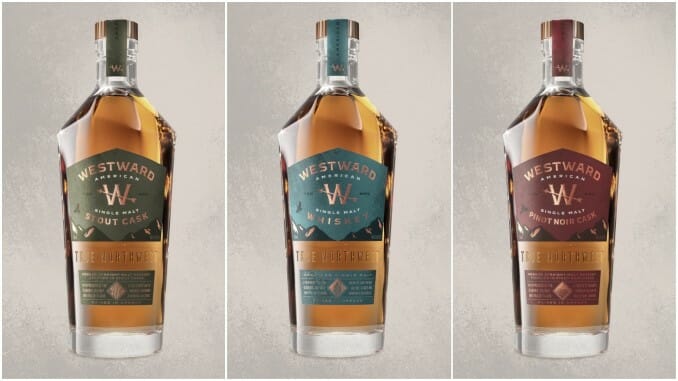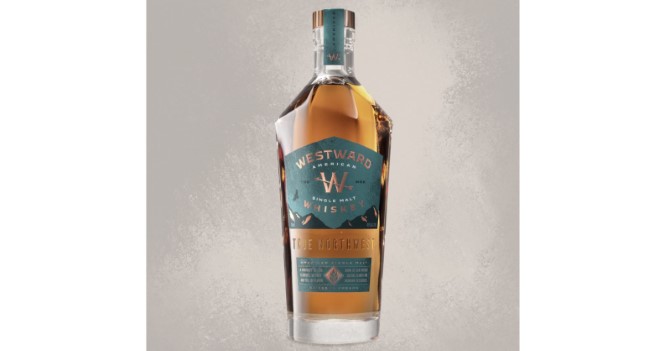Tasting: 3 American Single Malts From Westward Whiskey
Photos via Westward Whiskey, House Spirits Distillery
At this point, I’m beginning to lose track of how often I’ve written about American single malt in the last year. There was the trio of American single malts from Virginia Distillery Co., or the pioneering, Scottish-style McCarthy’s Oregon Single Malt. I’ve also tasted American single malt blends such as Lost Lantern, which celebrates the style itself. Suffice to say, it’s a style of whiskey I’ve come to know pretty well at this point, although it always takes at least a degree of explanation to make the average consumer know exactly what to expect. So let’s get that out of the way.
American single malt whiskey is exactly what it sounds like—malt whiskey from a single distillery, made in the U.S., rather than the likes of Scotland. Some American single malts are made in exactly the way they would be in Scotland, aged in reused American oak (usually bourbon) barrels. Many, however, buck the Scottish style by instead aging their malt whiskey in newly charred barrels, which serves to take the style in a bolder and decidedly American direction, lending them a flavor profile with more in common with bourbon. Every year, this style of American single malt has been gaining market share.
One specialist in this particular subset of American single malts is Portland’s Westward Whiskey. Produced by House Spirits Distillery, which is perhaps best known for distilling Aviation Gin, Westward is not to be confused with the similarly named Westland, a Seattle distillery that also specializes in American single malt. Between them and McCarthy’s, however, you could say that this unofficially makes the Pacific Northwest into the epicenter of the American single malt whiskey movement.
Westward is one of those distilleries I’ve been aware of for years, but had never had a chance to sample until recently. I was able to taste samples of the flagship single malt, along with its pinot noir cask and stout beer cask variants, so let’s see how they stack up.
Westward American Single Malt Whiskey
The flagship American single malt whiskey from Westward is non-age-stated, but likely between 2-5 years of age, is aged in newly charred oak, and bottled at a respectable 45% ABV (90 proof). The MSRP of $70 definitely reflects a “craft spirits” ethos, similarly priced to the flagship of other companies such as Virginia Distillery Co. Accepting a higher price tag (and higher still, for the variants) just comes with the territory here.
On the nose, this one is immediately big, bold, sweet and roasty, with prominent notes of coffee and dark chocolate—very mocha indeed. It’s funny that one of the variants is aged in barrels that formerly held stout beer, because this one already has several “stouty” qualities. I’m also getting more of a musty grain/maltiness, and an oatmeal-like cereal note, sweetened with molasses. Simultaneously, there’s a pretty big fruit component of banana and orange. All in all, there’s no mistaking the newly charred oak—it has really put a big charge of roastiness and dark chocolate into the nose of this whiskey, which smells quite decadent and sweet side-forward.
On the palate, the sweetness continues—I’m getting orange vanilla cream and more of that mocha-coffee roastiness. It’s slightly syrupy, but stops short of being saccharine. Beyond the sweetness, there’s more toasted malt and some stone fruit/banana on display, but all in all this is pretty decadent. It’s as clear an example as I’ve ever come across of how American single malt can really differ from Scottish malts that are otherwise similar recipes, solely because of the fact that they’re entering virgin oak. This one, for whatever reason, has drawn out the sweetest elements of the barrel, giving the char a desserty dimension. Overall, I find myself actually quite enjoying this profile, as the sweet roastiness is reminiscent of high quality espresso or affogato (espresso with ice cream), but it never strikes me as cloying.
Westward American Single Malt Pinot Noir Cask
This pinot noir cask version of Westward’s American single malt is dedicated to Oregon’s Willamette Valley wine region, which is of course known for pinot noir. It is finished for “up to two years” in French oak wine casks from Oregon, and bottled at the same 45% ABV (90 proof). MSRP is $90.
On the nose, some of those notes here are similar—it displays the same sweetness and roast/coffee/chocolate, but it’s simultaneously brighter and more evocative of tartness. I’m not sure if the nose actually makes me think “vinous” necessarily, but there’s an indication of something considerably more fruity.
On the palate, this is indeed more bright, tart and fruit driven, although I would liken the fruit to something more like tart apple. My mind is drifting to the flavor of apple brandy aged in newly charred oak, if that makes sense. The roastiness is still a huge component, but I’m also getting more lingering honeycomb and fresh biscuits. There’s a Biscoff cookie-like combo of gentle cinnamon/brown sugar/toast as well. Once again, I’m not sure anything here necessarily makes me think of pinot noir specifically, but it’s still an intriguing variation on the template.
Westward American Single Malt Stout Cask
I’ve tasted a variety of spirits at this point that are aged in barrels that previously held beer, and it’s often been difficult to decide whether this practice is really contributing flavor in a noticeable or desirable way. Beer finished in a spirits barrel is assertively impacted because it’s coming in contact with powerful flavors and an oak barrel, to which it had not previously been exposed. Spirits aging in a “beer barrel” is a bit more esoteric a concept—the “beer barrel” was already a spirits or wine barrel to begin with, so it’s up to the beer itself to affect the flavor profile of the spirit at this point. Typically, this seems to modify the spirit in modest or subtle ways.
Here, Westward’s American single malt has been stuck back into its own barrels, after those barrels were used to age imperial stouts. The whiskey is then allowed to age one year in the newly dubbed “stout seasoned” casks. It’s bottled at the same 45% ABV (90 proof) and $90 MSRP.
On the nose, the big thing that has changed here is that the whiskey has been infused with some much more assertive nutty notes—lots of roasted almond/hazelnut. At the same time, I’m finding the fruit notes less easy to pick up. On the palate, it’s heavy on chocolate-covered espresso beans, but it almost seems to have picked up some of the astringency that is sometimes present in beers brewed with high proportions of deeply roasted malt. This is quite “stouty” indeed—although really, the flagship whiskey already had some of these qualities—but it seems unbalanced in favor of it roastier flavor profile. All in all, I find myself ultimately preferring the flagship Westward Single Malt, which as a more balanced profile that if lifted by its elements of fruit in addition to the sweet roastiness.
Jim Vorel is a Paste staff writer and resident brown liquor geek. You can follow him on Twitter for more drink writing.










































